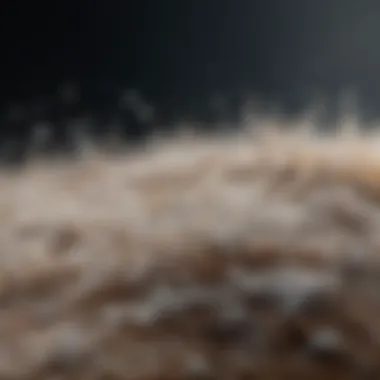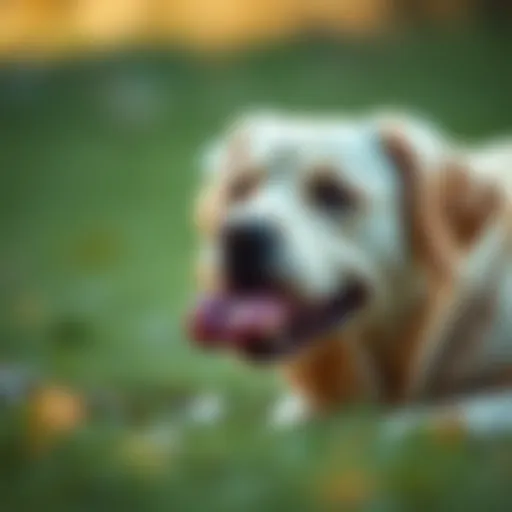Understanding and Addressing Labrador Dandruff Issues


Intro
Labrador Retrievers are one of the most beloved breeds around the world. They are known for their friendly nature and intelligence. However, like all dogs, they can face health issues, one of which is dandruff. Dandruff in Labradors manifests as flakes of dead skin found in their coat. While it may appear harmless, it often indicates underlying issues that require attention. This article aims to provide a thorough understanding of Labrador dandruff, including its causes, symptoms, and effective treatment strategies.
Animal Overview
Common Name and Scientific Classification
Labrador Retrievers are categorized scientifically as Canis lupus familiaris. They are descendants of the St. John's dog and belong to the sporting group of dog breeds. Their friendly demeanor and trainability make them popular choices as family pets and service dogs.
Physical Characteristics
Labradors have a robust build with a short, dense, water-repellent coat. Their fur is typically found in three primary colors: black, yellow, and chocolate. Labrador Retrievers often exhibit a broad head with a pronounced stop, expressive eyes, and a strong neck. Their tails are thick at the base and taper towards the end, commonly referred to as an
Intro to Labrador Dandruff
Understanding the issue of dandruff in labrador retrievers is crucial for pet owners. This condition not only affects the aesthetic appeal of the coat but can also indicate underlying health problems. For many pet owners, recognizing the signs of dandruff can lead to early interventions that improve the dog’s comfort and overall well-being.
Dandruff is characterized by the presence of white flakes on the dog's fur and skin. While it may seem like a minor issue, it can be a symptom of more serious concerns such as allergies, skin infections, or nutritional deficiencies. Proper understanding of this condition can help in choosing suitable care strategies.
Understanding Dandruff
Dandruff results from the shedding of dead skin cells. The cells accumulate and mix with oils, creating flakes that may appear on the fur. In dogs, several factors could contribute to this condition, and careful scrutiny may be needed to pinpoint the exact cause.
Common causes include dry skin, allergic reactions, and improper grooming practices. Maintaining regular grooming can help reduce these dead skin cells but may not resolve the root issues. It is essential for owners to pay attention to their dog's skin and coat condition.
Prevalence in Labradors
Labrador retrievers are particularly susceptible to dandruff for several reasons. The breed’s coat, while generally thick and water-resistant, can sometimes fail to retain moisture effectively, leading to dryness. This makes them more prone to environmental factors that can trigger dandruff.
Additionally, Labradors are known for their playful yet sometimes messy behavior. Exposure to dirt, dust, and various allergens can exacerbate skin conditions in this breed. Studies show that conditions such as seborrheic dermatitis can also be prevalent, thus increasing the likelihood of observing dandruff.
Anatomy of Labrador Skin
The skin of a Labrador is complex and serves multiple vital functions. Understanding its anatomy is crucial for pet owners who need to address dandruff issues effectively. The structure of the skin not only protects the underlying tissues but also plays a role in temperature regulation, sensation, and the overall health of the fur. When a Labrador experiences skin issues, such as dandruff, it is often indicative of problems within this intricate system.
Structure of Labrador Fur
The fur of the Labrador Retriever consists of two primary layers: the outer coat and the undercoat. The outer coat is composed of water-resistant guard hairs, while the undercoat is softer and denser, providing insulation. This dual-layer structure enhances protection against environmental elements and contributes to their distinctive look.
The health of this fur is directly linked to the condition of the skin beneath it. When the skin is healthy, it produces natural oils that keep the fur shiny and help prevent dryness. Conversely, any disruption, such as excessive flaking or irritation, can compromise the coat's appearance and texture.
Significance of a Healthy Coat
Maintaining a healthy coat is paramount for any Labrador. A well-kept coat is not only aesthetically pleasing but also plays an essential role in the dog's overall health. Labradors are susceptible to various skin issues, including dandruff, which can indicate underlying health problems.
Key benefits of a healthy coat include:
- Protection from Elements: A robust coat shields the skin from sun, moisture, and temperature extremes.
- Insulation: The fur traps heat in cold weather and allows temperature regulation in warmer conditions.
- Skin Health: A healthy coat fosters an environment where the skin can stay hydrated and less prone to infections.
To maintain the health of a Labrador's coat, regular grooming, appropriate nutrition, and consistent veterinary care are imperative. This proactive approach can mitigate the risk of dandruff and other skin-related issues.
“The skin is the largest organ of the body. Its health is a reflection of the overall well-being of the dog.”
Common Causes of Dandruff in Labradors
Understanding the common causes of dandruff in Labradors is crucial for any pet owner aiming to ensure their dog's health and comfort. Dandruff often indicates underlying issues that require attention. By identifying these causes, owners can take proactive measures to alleviate the problem and improve the overall well-being of their pets. This section explores specific elements contributing to Labrador dandruff and underscores the importance of addressing these factors early.
Allergies and Sensitivities
Allergies can play a significant role in the development of dandruff in Labradors. These can stem from various sources such as food, pollen, dust mites, and chemicals. When a Labrador's immune system reacts to an allergen, it can lead to inflammation and skin irritation. This results in excessive itching and scratching, leading to the shedding of skin cells, or dandruff.


Foods commonly associated with allergies include:
- Beef
- Chicken
- Wheat
- Soy
When considering allergies, conducting an elimination diet under the guidance of a veterinarian can be effective in pinpointing the specific allergens affecting the Labrador. Identifying and removing allergens from the dog's environment or diet can significantly reduce dandruff and improve skin health.
Skin Infections
Skin infections, whether bacterial or fungal, are other common culprits behind Labrador dandruff. These infections can arise from a variety of causes, including bacteria that thrive in moist environments or fungi such as yeast. Infections often manifest as redness, swelling, and irritation, which can exacerbate dandruff.
Routine veterinary check-ups are important in diagnosing these infections early. Treatment usually involves topical or oral medications, depending on the severity of the condition. Keeping the dog's skin clean and dry can also help prevent the recurrence of infections.
Nutritional Deficiencies
Nutritional deficiencies can lead to poor skin health and increased dandruff in Labradors. Omega-3 and Omega-6 fatty acids, for instance, are essential for maintaining a healthy coat. A lack of these nutrients can lead to dry skin and less resilience against environmental stresses.
A balanced diet considering the dog's specific needs is critical. Key nutrients to include are:
- High-quality proteins
- Essential fatty acids
- Vitamins and minerals, particularly Zinc
Consulting with a veterinarian about the appropriate diet can ensure that all nutritional needs are met, which may subsequently reduce dandruff-related issues.
Environmental Factors
Environmental factors play a pivotal role in the skin condition of Labradors. Extreme temperatures, low humidity, and exposure to irritants like smoke or cleaning chemicals can contribute to skin dryness and irritation. Change in seasons may also affect a dog's skin health, leading to an increase in dandruff.
Taking preventive measures can significantly help. Provide a humidifier during dry months, use pet-friendly cleaning products, and keep the dog's living area clean. Monitoring these environmental aspects can lead to a noticeable improvement in the dog's skin condition, potentially reducing dandruff.
Effective management of these common causes of dandruff can promote a healthier coat and improve the quality of life for Labradors. Regular monitoring and veterinary consultations are essential steps for any pet owner in addressing this concern.
Symptoms Associated with Dandruff
Understanding the symptoms associated with dandruff in Labradors is crucial for timely intervention and treatment. The visible signs of dandruff can indicate underlying issues that may require addressing to ensure the dog’s overall health. Recognizing these symptoms can lead to better management decisions, thus improving the quality of life for the pet. The symptoms may vary in severity, but they significantly impact the dog's comfort and well-being.
Visible Flaking
Visible flaking is often the most noticeable symptom of dandruff in Labradors. Owners may observe small white or yellowish flakes scattered through the dog's fur or on its bedding. This flaking results from dead skin cells accumulating on the skin surface. Environment, dietary choices, and grooming practices can all contribute to its occurrence. If left unaddressed, this visible issue can lead to further skin irritations, potentially resulting in discomfort or infection. Regular grooming can help remove these flakes and provide insight into the condition of your dog's skin.
Itching and Irritation
Itching and irritation are closely related to the presence of dandruff. A Labrador displaying increased scratching or rubbing of its skin may be experiencing discomfort from dry or flaky skin. Persistent scratching can lead to open wounds or secondary infections, complicating the original issue. Observing your dog’s behavior can provide critical clues about its skin health. Intervention strategies may include topical treatments or adjustments to diet and routine to help soothe the irritation and restore skin balance.
Odor and Discoloration
An unusual odor or discoloration of the coat can also signify dandruff. When skin becomes irritated or infected, it may produce a foul smell. This is often associated with a bacterial or yeast overgrowth triggered by an unbalanced skin environment. Additionally, discoloration may appear as red or inflamed patches, indicating inflammation beneath the surface. Such symptoms should prompt a veterinary consultation to rule out any serious underlying conditions and initiate appropriate treatment.
Pro Tip: Early recognition of these symptoms is key to effective management. Regular observation and care can prevent more serious health issues down the road.
Diagnostic Approaches
In addressing dandruff issues in Labrador Retrievers, diagnostic approaches play a fundamental role. Understanding the underlying causes of dandruff is crucial for effective treatment. Each diagnostic method provides unique insights into the specific issues affecting a dog's skin condition.
Veterinary Consultation
Consulting a veterinarian is often the first step. A professional veterinarian can examine your Labrador's skin condition thoroughly. They can identify potential causes of dandruff that may not be obvious to pet owners. This may include allergies, infections, or nutritional problems.
The veterinarian may ask questions about your dog's history. Details like diet, grooming habits, and any recent lifestyle changes are relevant. Understanding these factors can reveal essential information. A proper examination ensures that the dog receives appropriate and timely treatment.
Skin Scraping Tests
Skin scraping tests can be an essential diagnostic tool. This test involves taking a small sample of the skin and examining it under a microscope. The veterinarian looks for parasites, such as mites or fleas, which might cause the dandruff.


This test is relatively simple and quick. It can provide immediate clues about the underlying condition. If parasites are detected, specific treatments can be initiated promptly. A positive outcome from this test can lead to targeted treatment protocols, improving the dog's skin health effectively.
Allergy Testing
Allergy testing is another valuable step in diagnosing dandruff. Labradors can be sensitive to various allergens found in their environment or food. Tests can determine if the dandruff stems from allergic reactions.
These tests often involve blood tests or skin tests to identify specific allergens. Understanding the allergens can lead to better management of the environment. Moreover, eliminating allergens may significantly improve the skin condition over time, reducing dandruff and irritation.
Effective diagnosis is key to ensuring proper treatment for Labrador dandruff issues. By identifying specific causes, owners can tailor interventions that promote skin health and overall well-being.
Treatment Options for Labrador Dandruff
Addressing the issue of dandruff in Labrador Retrievers requires a multifaceted approach. Understanding the available treatment options is crucial for pet owners seeking to improve their dog's skin health. These treatments not only alleviate discomfort but also contribute to a healthier coat. Each option offers unique benefits and may need consideration based on the individual dog's needs.
Medicated Shampoos
Medicated shampoos serve as a frontline defense against dandruff. These shampoos contain active ingredients that target specific causes of dandruff, including inflammation and yeast infections. Common ingredients include benzoyl peroxide, salicylic acid, and antifungal agents. The use of medicated shampoos should be tailored to the dog's condition, and they may need to be used weekly or bi-weekly, depending on severity.
When using medicated shampoos, it is important to follow the veterinarian's recommendations. Overuse may lead to skin irritation. Ensure thorough rinsing to prevent any residue from aggravating the skin. Proper application can lead to noticeable improvements in coat condition, which can enhance overall comfort and reduce itching.
Dietary Adjustments
Diet plays a pivotal role in the health of a Labrador’s skin and coat. Adjusting diet, particularly with increased omega-3 and omega-6 fatty acids, can help reduce inflammation and improve skin hydration. Foods high in these fatty acids include fish oil, flaxseed oil, and certain commercial dog foods designed to promote skin health.
Consideration should also be given to potential food allergies. A diet free from common allergens, such as beef or chicken, may lessen skin irritations. Consultation with a veterinarian to assess dietary sensitivities can offer insights into necessary dietary corrections. Overall, proper nutrition can result in reduced dandruff and improved skin condition.
Supplements for Skin Health
In addition to dietary adjustments, supplements specifically formulated for skin health may provide added benefits. Vitamin E, biotin, and zinc are crucial for maintaining skin integrity. These supplements can enhance the skin barrier function and promote healing.
When selecting supplements, it is vital to choose high-quality products designed for pets. Some brands may offer formulas specifically tailored for Labrador Retrievers. Regular intake of these supplements may contribute to a condition-free coat over time. Always discuss supplement options with a veterinarian to ensure they are appropriate for your pet's individual health profile.
Environmental Control Measures
Environmental factors can significantly impact a Labrador’s skin condition. Humidity levels, temperature, and exposure to allergens can exacerbate dandruff. Implementing control measures can help mitigate these factors. For instance, maintaining stable indoor humidity and temperature can assist in preventing dry skin during harsh weather.
Additionally, minimizing exposure to known allergens, such as pollen and dust, is beneficial. Routine cleaning and reducing carpeted areas can limit irritants in the home. Regular bathing with suitable shampoos can also help remove allergens from the coat, leading to a healthier skin condition.
Regular skin care and environmental adjustments are fundamental in managing dandruff effectively.
In summary, addressing Labrador dandruff requires a combination of medicated products, dietary changes, supplements, and environmental management. Together, these treatment options can foster healthier skin and overall well-being for your pet.
Preventative Care Strategies
Preventative care strategies are essential in tackling dandruff issues in Labrador Retrievers. These measures not only promote skin health but also enhance the overall quality of life for the dog. By adopting effective preventative strategies, owners can significantly reduce the risk of dandruff and related skin problems.
Regular Grooming Practices
Regular grooming plays a critical role in maintaining a healthy coat and skin for Labradors. Grooming helps remove loose fur and dead skin cells, which are common contributors to dandruff. Methods to implement effective grooming include:
- Daily brushing: This helps to distribute natural oils evenly throughout the coat.
- Proper bathing: Use gentle, moisturizing shampoos specifically designed for dogs. Overbathing can strip natural oils, worsening the condition.
- Inspection for skin issues: During grooming, check for signs of irritation, redness, or unusual flaking, which can indicate developing problems.
Grooming can also serve as a bonding activity between the owner and the pet, further supporting emotional well-being.
Hydration and Nutrition
Hydration and nutrition have a significant impact on the skin health of Labradors. A well-balanced diet that includes essential fatty acids and sufficient hydration is crucial. Here are important considerations:
- High-quality dog food: Special formulations that include omega-3 and omega-6 fatty acids can promote skin and fur health. Brands like Blue Buffalo or Royal Canin offer options that can be beneficial.
- Fresh water availability: Always ensure clean, fresh water is accessible to your dog. Dehydration can lead to dry skin, encouraging dandruff formation.
- Supplementation: Adding supplements like fish oil can also enhance skin condition. Consult a veterinarian for appropriate dosage and types.
Proper hydration and nutrition function as the backbone of skin care, reducing the likelihood of skin irritation and dandruff.


Routine Veterinary Check-ups
Routine veterinary check-ups are pivotal for the preventive care of Labradors, especially when it comes to skin health. Regular visits can help in early identification of potential issues before they escalate. Important points include:
- Skin assessments: Veterinarians can assess skin condition during check-ups and recommend additional treatments if necessary.
- Vaccinations and parasite control: Keeping your Labrador updated on vaccinations and addressing flea or tick infestations are essential for overall skin health.
- Dietary recommendations: Veterinarians can provide tailored dietary advice to ensure your Labrador's nutritional needs are met, impacting skin health positively.
Regular veterinary consultations are not only about addressing current issues; they are also a proactive measure for long-term health!
Adopting these preventative care strategies can greatly enhance the health and quality of life for Labrador Retrievers. Committing to regular grooming, proper nutrition, and routine veterinary visits creates a solid foundation for addressing and preventing dandruff in these beloved pets.
Behavioral Aspects of Dandruff Management
Understanding how to manage the behavior of your Labrador in relation to dandruff is essential. This can improve not only the dog's comfort but also the effectiveness of any treatments used. Behavior plays a role in skin health, and recognizing changes can provide insights into underlying issues. Ultimately, addressing these behaviors and ensuring an accommodating environment contributes to a healthier coat and overall well-being.
Monitoring Changes in Behavior
Behavioral changes in Labradors can be indicative of dandruff or related skin issues. It is crucial to observe your dog closely. For instance, increased scratching or biting at the skin usually signals discomfort. Early recognition of these symptoms can lead to timely intervention, which is essential for effective management.
- Key behaviors to watch for:
- Excessive scratching or licking
- Pacing or signs of anxiety
- Changes in playfulness or energy levels
Collecting data on these behaviors can assist veterinarians in diagnosing the issue. Keeping a daily log may help identify patterns or triggers related to your dog’s skin condition. An ongoing evaluation of behavior informs which treatment strategies may be more appropriate.
Creating a Comfortable Environment
Creating a comfortable living space is vital for your Labrador's overall health. A stress-free environment can help alleviate some dandruff issues, especially when they are exacerbated by irritation or anxiety. This involves several considerations.
- Humidity and Temperature:
- Bedding and Rest Areas:
- Limit Exposure to Irritants:
- Routine:
- Labs are sensitive to extreme temperatures. Ensure proper heating or cooling based on the season to maintain comfort.
- Use soft, washable bedding to provide a cozy rest area. Regularly cleaning these spaces helps reduce allergens and irritants that could worsen the dandruff.
- Identify and minimize exposure to potential allergens in the environment, such as dust, mold, or certain fabrics.
- Establishing a consistent routine for feeding, grooming, and playtime can help reduce stress in your Labrador. Animals thrive on stability.
Maintaining a comfortable environment not only helps with behavioral aspects but also supports the overall health of your Labrador's skin.
In summary, focusing on the dog's behavior and environment can play a significant role in managing dandruff. Recognizing symptoms early and providing a comfortable living space can significantly improve the well-being of your Labrador.
End
The conclusion acts as a capstone to the information presented in this article about Labrador dandruff. It's crucial because it synthesizes the knowledge shared, focusing on conditions affecting Labrador Retrievers. Through a thorough understanding of the causes, symptoms, and remedies discussed, pet owners can navigate this issue more effectively. A clear summary provides a quick reference, ensuring that the key points remain fresh in the minds of readers.
The relevance of proactive care cannot be overstated. Regular monitoring of a dog's skin health can prevent small issues from escalating into larger problems. Understanding the importance of routine veterinary check-ups fosters a healthier environment for the dog, ultimately enhancing its quality of life.
Summary of Key Points
The article has examined several crucial aspects of Labrador dandruff:
- Understanding Dandruff: Identifying what dandruff is and its prevalence among Labradors provides foundational knowledge.
- Common Causes: Allergies, skin infections, nutritional deficiencies, and environmental factors all contribute to this issue.
- Symptoms: Visible flaking, itching, and odor are key indicators of dandruff that owners should monitor.
- Diagnostic Approaches: Methods such as veterinary consultations, skin scraping tests, and allergy testing can accurately identify the problem.
- Treatment Options: Medicated shampoos, dietary modifications, and supplements offer pathways to manage dandruff effectively.
- Preventative Care: Regular grooming and hydration play a significant role in maintaining skin health.
- Behavioral Management: Recognizing behavioral changes related to skin issues is essential in addressing the dog's overall well-being.
These points are essential to understanding and addressing the dandruff issues faced by Labradors.
Importance of Proactive Care
Proactive care goes beyond merely addressing the symptoms of Labrador dandruff. It represents a holistic approach towards pet health. Engaging in regular grooming establishes a routine that benefits the dog’s coat and skin. It is particularly important for Labradors, whose fur can trap dirt and allergens.
Maintaining proper hydration and nutrition provides the necessary foundation for healthy skin. A well-balanced diet enriched with essential fatty acids promotes a lustrous coat while minimizing flaking.
Routine veterinary check-ups are vital. These appointments enable early detection of potential skin issues before they escalate into more serious health concerns.
By being proactive, pet owners invest in the long-term welfare of their Labradors, ensuring they remain happy and comfortable.
Informed pet owners can prevent minor issues with their Labradors from becoming serious, impacting overall skin health and quality of life.







